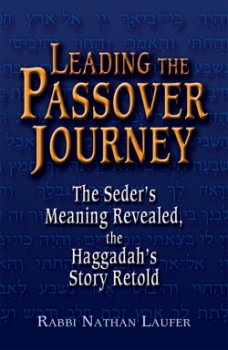

|

IS THIS BOOK FOR YOUR GROUP?
Have you or other members of your group ever planned or led a Passover Seder? Have you ever wanted to? Do you want your Seder to be more meaningful or exciting? This book will help your group share and explore old and new ideas together and learn how to transform yourselves from reluctant bystanders to enthusiastic participants at your next Passover Seder. Rabbi Laufer’s insights will help you and your group members discover the hidden meanings of familiar rituals that you may not have thought about for a long time, if at all.
|
6 x 9, 224 pp, Paperback, 978-1-58023-399-6
|
|
|
|
|
Enrich Your Passover Seder with Renewed Meaning and Significance Whether you are planning to participate in, contribute to, or lead a Passover Seder, Leading the Passover Journey will help you relive the Jewish People’s legacy of survival, hope, and redemption, and reconnect with the rich heritage celebrated in this special event. Reclaim the hidden meaning of the Passover Seder. Connect the pieces of the Haggadah narrative into one meaningful, cohesive story. From preparing for Passover to understanding the order of the Seder, from eating the meal of freedom in the house of slavery to reenacting the saga at the sea, this fascinating exploration of the texts and traditions surrounding the most celebrated event in the Jewish calendar will awaken latent knowledge and provide new understanding. It will empower you to fully understand and identify with the complete story of the Jewish People’s journey of liberation.
“A superb guide to the journey of the Passover Seder. Taking the reader step-by-step through the experience, Rabbi Laufer offers both novice and experienced Seder participants a road map filled with delicious details, exemplary explanations, and intellectual insights to enhance their Seder celebration. A highly recommended, terrific resource!”
—Dr. Ron Wolfson, author, Passover: The Family Guide to Spiritual
Celebration, and vice president, University of Judaism, Los Angeles “A profoundly insightful, lovingly crafted, and eminently useful guide to the Passover Seder that unlocks the Haggadah’s deepest layers of meaning. Indispensable for all Seder leaders. Guaranteed to enrich any Passover Seder.”
—David Arnow, PhD, author, Creating Lively Passover Seders:
A Sourcebook of Engaging Tales, Texts & Activities “More than an invaluable resource for everyone who leads a Seder, this book uses the Passover Haggadah as a prism through which to examine the story of the Jewish People. It makes us think about the past even as it challenges us to reflect upon our own Jewish lives today.”
—Deborah E. Lipstadt, PhD, director, Rabbi Donald Tam Institute for Jewish Studies, Emory University
Download a printable version - Think about the purpose of the Seder plate, the three Matzahs, the four cups of wine, Elijah’s cup. What does the symbolic meaning of these rituals teach us about the deeper meaning of ritual in the Jewish tradition?
- There is an organizing principle used in the formulation of the Four Questions and the answer “We were slaves in Egypt …” Why do you think the Haggadah’s authors “hid” the underlying structure of the Four Questions in the re-telling of the Passover story?
- Through the re-telling of the story of the Exodus in the Haggadah, what were the authors of the Haggadah trying to convey to us about our importance as storytellers of our personal and collective histories?
- A plethora of folk songs are traditionally sung toward the end of the Passover Seder. How do these meaningful melodies and music help us achieve the goals of the Passover Seder?
- What are the two elements that the Passover Haggadah explicitly states should be recalled “in every generation” (bechol dor va’dor )? What do these teachings tell us about the author’s view of Jewish national existence? Do you find these messages to still be relevant to our period of Jewish history and personal identity?
- In what way does your personal life journey mirror the journey of the Jewish People in the Exodus? How might that parallelism inform the value of Torah/scripture for the rest of your life?
Rabbi Laufer, why did you write this book?
Passover is the most widely celebrated festival of the Jewish year. Over 90 percent of American Jews attend a Passover Seder of one sort or another. In my travels back and forth across North America and throughout the Jewish world, I have found a tremendous hunger among Jews and non-Jews to learn more about the Jewish tradition in general, and Passover in particular. I wanted to contribute something of enduring value to understanding this pivotal holiday in our heritage. With all due respect, there are already so many books out there on Passover offering various interpretations of the Passover Haggadah. What does your book contribute that the others have not?
Although I was trained as a rabbi and a lawyer, I see myself ultimately as a concerned (and passionate!) Jewish educator. From an educational point of view I have found two glaring faults with many (not all!) of the books out there regarding Passover. They tend to be either distantly removed from the essential story of the Exodus or they offer only fragmented commentaries on the Haggadah text. By distantly removed I mean that they often explain the pieces of the Haggadah in spiritual or mystical terms without reference to the concrete biblical story upon which they are based. By fragmented I mean that many of these books provide insights into this or that word, this or that paragraph, but, most often, they do not link those insights—they do not connect the dots—into a coherent whole. Can you give me an example of an interpretation that is distantly removed from the biblical text and how, in contrast, you interpret it?
Sure. I have seen many Haggadahs that have explained the tradition of eating matzah on Passover as a conscious attempt to humble the spirit of the one imbibing the matzah bread. According to this line of interpretation, the matzah, being a type of “flat bread,” is meant to symbolize the need of the religious person to “deflate” the ego and suppress the natural inclinations in serving God. That line of reasoning sees religion generally, and the central symbol of Passover in particular, as being about the struggle to suppress the individual’s will in the face of the Divine command. Whatever the merits of this theology and line of interpretation, I do not believe that is what matzah means in the context of the Exodus story. Matzah, “poor man’s bread,” was the Bible’s vehicle to nurture communal solidarity among our ancestors in Egypt who were enslaved and impoverished by their Egyptian taskmasters and then freed and financially replenished by a caring and loving God. In my view, the primary message of Judaism and Passover is precisely this visceral identification with our biblical and contemporary brothers and sisters in suffering and redemption. Indeed, it is the failure to identify with our ancestors, rather than the failure to submit to God, that is considered the cardinal sin in the Haggadah text for which one earns the ignominious title of being “the wicked son.” How do you address the issue of the fragmentary nature of the Passover Seder in your book?
Actually, the Seder is anything but fragmentary! The word Seder means “order, structure” and the Passover Seder is one of the most brilliantly and intricately structured rituals in all of Jewish life. Each of the fifteen pieces of the Passover Seder is a symbolic re-telling of the story of the Exodus from Egypt in the precise order in which those events unfolded millennia ago. We relive that story every Passover when we lead or participate in the Seder. It took me twenty years to figure out the code of the Passover Seder in its entirety, but the reader of this book can grasp how all of the pieces fit together in just a couple of hours. Wow! Twenty years! This book must be pretty scholarly if it took you that long to write it. Is this book intended primarily for scholars and people with lots of previous knowledge?
Not at all! My whole life’s work as a Jewish educator has been to take complex subjects in the Jewish tradition and make them accessible to the average, curious person without being overly simplistic. I’ve taught the material in this book to grade school, high school, and graduate students; to plain folk and communal leaders; and to rabbis and scholars. Amazingly, everyone comes away having an “Aha!” experience, visibly excited about the new meaning that they were able to derive from their Passover journey. What is the best way to get maximum value out of reading Leading the Passover Journey?
There is a Jewish tradition that suggests preparing for Passover thirty days before the holiday. There is another tradition to recite the core narrative of the Haggadah on the Sabbath prior to the holiday. If people want to feel ready to embark on the Passover journey and to get the most out of the Passover experience, then what they need to do is set aside a couple of hours and read through the book in advance of the holiday. If individuals are part of a book club, they can then hold a discussion about the book anytime between a month and a few days before Passover. That way they will get the big picture of what the Seder is about and also understand how each of the individual pieces contributes to re-telling that story in a meaningful way today. While every participant of a Passover Seder will get added value from reading this book in advance, it is especially helpful to those of us who are responsible for leading part or all of the Passover Seder amongst family and friends. Of course, the book can always be referred to during the Seder itself to focus on specific points and generate spirited discussion. Is there anything else you want to add?
I love to hear from my readers! I welcome your questions, comments, and feedback sent to me through the kind offices of Jewish Lights and posted on this website. I am looking forward to hearing from you!
|
|
|

